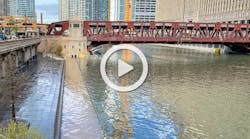
The Great Lakes are the largest freshwater system in the world, and they’re in trouble. Besieged by polluted runoff from cities and farmlands that have caused toxic algae blooms, invaded by foreign species from lampreys to Asian carp, and losing thousands of acres of vital adjacent wetlands to agriculture, they nevertheless continue to provide drinking water for 40 million people.
We’ve covered the efforts of the Great Lakes Restoration Initiative—a cooperative effort between the US and Canada—in Stormwater magazine, and this article from The Nature Conservancy’s magazine offers a detailed account of some current efforts to protect and restore the lakes. Together, the five lakes contain about one-fifth of the liquid freshwater on Earth. A few other facts:
- The lakes were formed by glacial activity 12,000 years ago. Lake Superior, the largest of the five interconnected lakes, is large enough to hold more than the volume of all the others combined.
- Lake Erie is the shallowest of the five, and thus the warmest and most prone to algae blooms.
- Of the many invasive plants surrounding the lakes—displacing native species and contributing to water-quality problems—one of the most tenacious and aggressive is baby’s breath, those tiny white and pink flowers you see in wedding bouquets and floral arrangements.
- About 125 million tons of cargo travel on the lakes each year.
- Industries surrounding the Great Lakes are responsible for 1.5 million jobs and contribute about $62 billion annually to the US economy, including billions of dollars from the timber industry.
- Michigan, Wisconsin, and Minnesota are working in partnership with a number of nonprofit groups to improve the health of forests around Lake Superior, helping loggers with replanting strategies that will increase biodiversity.
- Near Lake Huron, the Saginaw Bay Watershed Conservation Partnership and the Nature Conservancy have launched a “pay-for-performance” program that rewards farmers who adopt practices that keep sediment and nutrients from entering the lake.
Among the larger projects states and provinces that border the lake are working on are those to restore natural water flows, which have been disrupted over the last two centuries by dams, channels, and culverts. As part of a cross-border agreement, water managers in the US and Canada are working to mimic natural flows in Lake Ontario, which will help restore as much as 64,000 acres of wetlands along the shore.
The Great Lakes region has somewhere in the neighborhood of 4,000 dams and nearly 100,000 road-stream crossings; many of these are being removed or modified to improve fish passage, but the process is expensive. The University of Wisconsin – Madison and the Nature Conservancy have developed an online tool called Fishwerks to help determine which projects will have the greatest benefit.
About the Author
Janice Kaspersen
Janice Kaspersen is the former editor of Erosion Control and Stormwater magazines.

